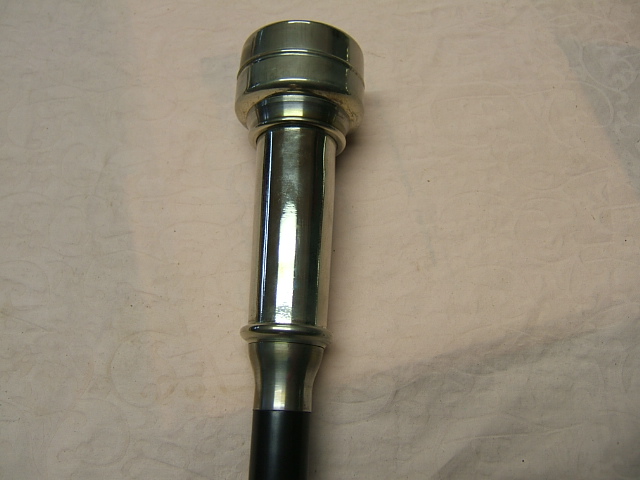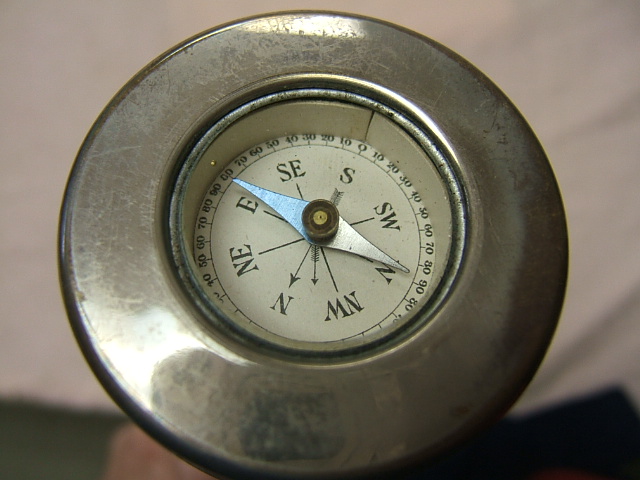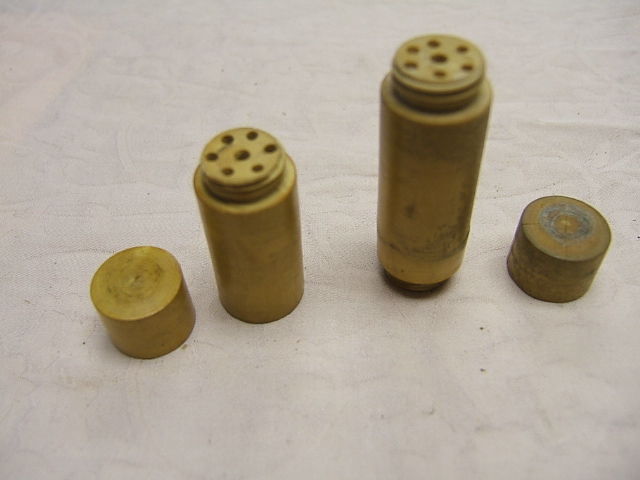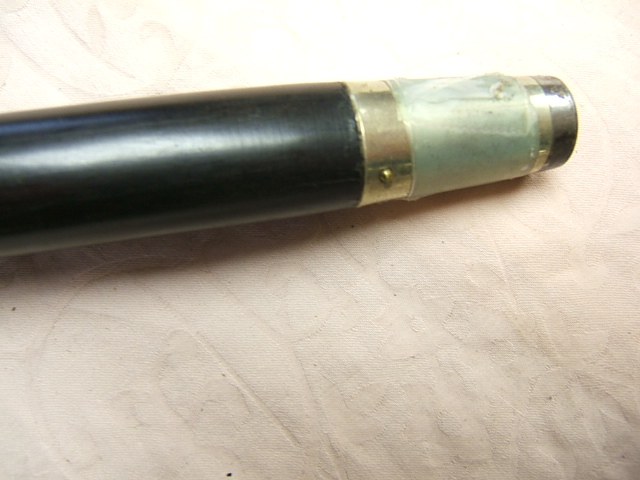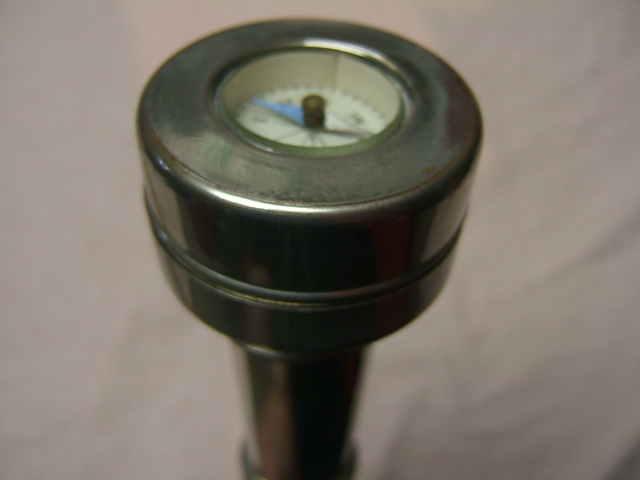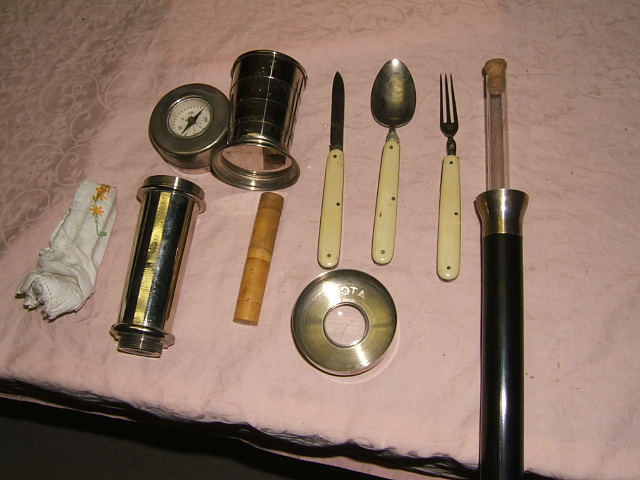 German Picnic With Cup And Flask (8340) German Picnic With Cup And Flask (8340)
This is the first description of an entire collection of 11 German picnic canes. I bought them in Germany over thirty years ago, all from one source. No two are the same, yet some have similar characteristics. I have never seen a duplicate to any of them anywhere else. I'm exposing them here for the first time, then I'm going to ask a german cane dealer to comment on them. As always I would like anybodies opinion on anything. I have yet to get one comment. It's July 23,2006 and I like making comments like this, because someday it will be a benchmark as to how far we have come.
Each cane in the collection will have the word German as the first word in the cane name above.
They are all nickel plated brass, some with leather, some with glass flask inside, some signed, a majority marked Germany or made in Germany. I've already covered this I won't repeat it all here, but when it's marked only Germany it was made between 1891 and 1914. Made in was made after 1914. As canes were pretty much done by 1930 we will assume that will be our ending date. Many have that speckled finish or graining on the shaft that indicates the shaft was made commercially by the thousands in Germany as tipplers.. They were wholesaled with flask to cane makers who would put their own handles on. Drilling the long holes and blowing the glass tubes was a specialized task. I have seen many different handles on these shafts. The most common is a fluted copper cap. The options were separate section at the top for a separate blown footed glass. The glass is often missing. Sometimes the glass is put in reverse on the end of the flask. When this is the case, the end of the tube is tapered smaller so the glass can overlap the tube. The stopper for the flask is a cork or an aluminum cap with a cork. I've seen one with two glasses and two sections at the top. When you see the tapered end and no flask it's missing.
The same company made another common gadget cane. The three section with the ink well and pencil in the top section and pen in the center, and sometimes a document hole in the bottom with the ferrule.. The pen can't be in the same section as the ink well. These canes have the same speckled finish as the flask, leading me to the conclusion they were the same maker. Both canes often had the same aluminum threads. These threads were weak and couldn't be repaired. Higher end makers put on lathe turned threads or hand chased on the flask canes. I've never seen a better handle on the pen and pencil tree section than the copper cap. Here's a freebe. In my opinion, the five most common gadget canes by type are.[I have no proof of this] #1 most common is sword cane. #2 Seat #3 Flask #4 umbrella with telescoping shaft. #5 Three section pencil and pen.
Our cane today is signed Atco Germany. It is smaller in size than 8334 and 8335, which have about the same functions, and I believe the same maker, but are only signed germany. Compass on top, collapsible cup beneath, magnifier to light a fire next, container with folding ivory knife, fork, spoon napkin and salt and pepper you canít spill. In the real ebony shaft is the glass flask. The cup fits perfectly in the container, and was obviously made for it. Has anyone seen the container as a separate piece. One possibility is that they were prototypes from the same company. Shortly I will be illustrating a group of prototypes from an American Co., and what is interesting is that the handle was patiented for non cane use. The date and patient # are stamped into the piece and it was very easy to trace whe intended use. In America we also see patient applied for, and in Germany D.G.R.M.with a patient #. Not one of these German canes has any # of any kind to prove they were made for non cane use. The majority of cane handles are not signed,no matter where they are made or who made them. The only law was, to come to America, they had to be marked with their country of origin. This also tells me, the ones that don't have germany on them weren't made for export, or they were never put into production. A lot of companies made prototypes, then decided it wasn't a good idea to make them. A lot of these have art deco influence which was near the end of the cane era.
It took me a long time to decide to put these canes in this book, because of the affect these could have on the creditability of this book. The experts tend to use the word fake, if the handle was made for another use, or they have never seen one, or they think its too big.
As this grouping of canes are not for sale, I decided the lessons they will teach us and the information I might gain from the comments of the experts, was worth the risk. The nice thing about the internet is, if it turns out this site is being critized because the educational material in it, its a simple thing to hit the delete button. I have nothing to lose, by not disclosing other experts opinions about controversial canes. After these read about the thermos prototypes starting with #8346,on page 8, as they have an added dimention of patent numbers.
Category: Gadget
Sub Category: City - Manufactured
Listed: 2006-07-24 10:59:52
|










 Online Video
Online Video




